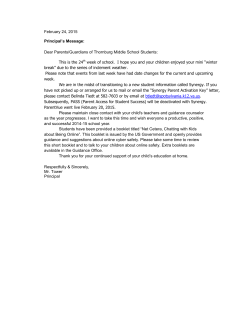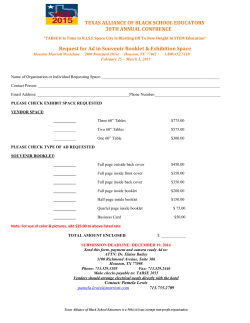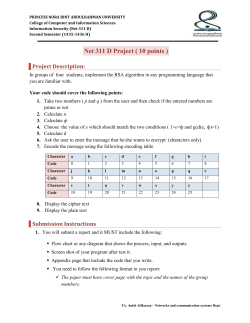
2015 - CEMC - University of Waterloo
The CENTRE for EDUCATION in MATHEMATICS and COMPUTING cemc.uwaterloo.ca Hypatia Contest (Grade 11) Thursday, April 16, 2015 (in North America and South America) Friday, April 17, 2015 (outside of North America and South America) Time: 75 minutes ©2015 University of Waterloo Do not open this booklet until instructed to do so. Number of questions: 4 Each question is worth 10 marks Calculators are allowed, with the following restriction: you may not use a device that has internet access, that can communicate with other devices, or that contains previously stored information. For example, you may not use a smartphone or a tablet. Parts of each question can be of two types: 1. SHORT ANSWER parts indicated by • worth 2 or 3 marks each • full marks given for a correct answer which is placed in the box • part marks awarded only if relevant work is shown in the space provided 2. FULL SOLUTION parts indicated by • • • • worth the remainder of the 10 marks for the question must be written in the appropriate location in the answer booklet marks awarded for completeness, clarity, and style of presentation a correct solution poorly presented will not earn full marks WRITE ALL ANSWERS IN THE ANSWER BOOKLET PROVIDED. • Extra paper for your finished solutions supplied by your supervising teacher must be inserted into your answer booklet. Write your name, school name, and question number on any inserted pages. √ • Express calculations and answers as exact numbers such as π + 1 and 2, etc., rather than as 4.14 . . . or 1.41 . . ., except where otherwise indicated. Do not discuss the problems or solutions from this contest online for the next 48 hours. The name, grade, school and location of some top-scoring students will be published on our website, cemc.uwaterloo.ca. In addition, the name, grade, school and location, and score of some top-scoring students may be shared with other mathematical organizations for other recognition opportunities. NOTE: 1. Please read the instructions on the front cover of this booklet. 2. Write all answers in the answer booklet provided. 3. For questions marked , place your answer in the appropriate box in the answer booklet and show your work. 4. For questions marked , provide a well-organized solution in the answer booklet. Use mathematical statements and words to explain all of the steps of your solution. Work out some details in rough on a separate piece of paper before writing your finished solution. Diagrams are not drawn to scale. They are intended as aids only. While calculators may be used for numerical calculations, other mathematical steps must be shown and justified in your written solutions and specific marks may be allocated for these steps. For example, while your calculator might be able to find the x-intercepts of the graph of an equation like y = x3 − x, you should show the algebraic steps that you used to find these numbers, rather than simply writing these numbers down. No student may write more than one of the Fryer, Galois and Hypatia Contests in the same year. 5. 6. 7. 1. Each Hypatia Railway train has one engine car followed by some boxcars in a straight line. The distance between consecutive boxcars is 2 m. The distance between the engine car and the first boxcar is also 2 m. The engine car is 26 m in length and each boxcar is 15 m in length. The total length of a train is the distance from the front of the engine car to the end of the last boxcar. (a) What is the total length of a train with 10 boxcars? (b) A train has a total length of 2015 m. How many boxcars does the train have? N train (c) In the diagram, a southbound train with 14 boxcars crosses the border between Canada and the United States at a speed of 1.6 m/s. Determine the length of time in seconds during which a portion of the train is in Canada and a portion is in the United States at the same time. Canada W United States E S 2. In the questions below, A, B, M, N, P, Q, and R are non-zero digits. (a) A two-digit positive integer AB equals 10A + B. For example, 37 = 10 × 3 + 7. If AB − BA = 72, what is the positive integer AB? (b) A two-digit positive integer M N is given. Explain why it is not possible that M N − N M = 80. (c) A three-digit positive integer P QR equals 100P + 10Q + R. If P > R, determine the number of possible values of P QR − RQP . 3. Consider n line segments, where each pair of line segments intersect at a different point, and not at an endpoint of any of the n line segments. Let T (n) be the sum of the number of intersection points and the number of endpoints of the line segments. For example, T (1) = 2 and T (2) = 5. The diagram below illustrates that T (3) = 9. (a) What do T (4) and T (5) equal? (b) Express T (n) − T (n − 1) in terms of n. (c) Determine all possible values of n such that T (n) = 2015. 4. Let gcd(a, b) represent the greatest common divisor of the two positive integers a and b. For example, gcd(18, 45) = 9 since 9 is the largest positive integer that divides both 18 and 45. The function P (n) is defined to equal the sum of the n greatest common divisors, gcd(1, n), gcd(2, n), . . . , gcd(n, n). For example: P (6) = gcd(1, 6) + gcd(2, 6) + gcd(3, 6) + gcd(4, 6) + gcd(5, 6) + gcd(6, 6) =1+2+3+2+1+6 = 15 Note: You may use the fact that P (ab) = P (a)P (b) for all positive integers a and b with gcd(a, b) = 1. (a) What is the value of P (125)? (b) If r and s are different prime numbers, prove that P (r2 s) = r(3r − 2)(2s − 1). (c) If r and s are different prime numbers, prove that P (r2 s) can never be equal to a power of a prime number (that is, can never equal tn for some prime number t and positive integer n). (d) Determine, with justification, two positive integers m for which P (m) = 243. 2015 Hypatia Contest (English) The CENTRE for EDUCATION in MATHEMATICS and COMPUTING cemc.uwaterloo.ca For students... Thank you for writing the 2015 Hypatia Contest! Each year, more than 200 000 students from more than 60 countries register to write the CEMC’s Contests. Encourage your teacher to register you for the Canadian Intermediate Mathematics Contest or the Canadian Senior Mathematics Contest, which will be written in November 2015. Visit our website cemc.uwaterloo.ca to find • Free copies of past contests • Math Circles videos and handouts that will help you learn more mathematics and prepare for future contests • Information about careers in and applications of mathematics and computer science For teachers... Visit our website cemc.uwaterloo.ca to • Obtain information about our 2015/2016 contests • Register your students for the Canadian Senior and Intermediate Mathematics Contests which will be written in November • Look at our free online courseware for senior high school students • Learn about our face-to-face workshops and our web resources • Subscribe to our free Problem of the Week • Investigate our online Master of Mathematics for Teachers • Find your school’s contest results
© Copyright 2025











